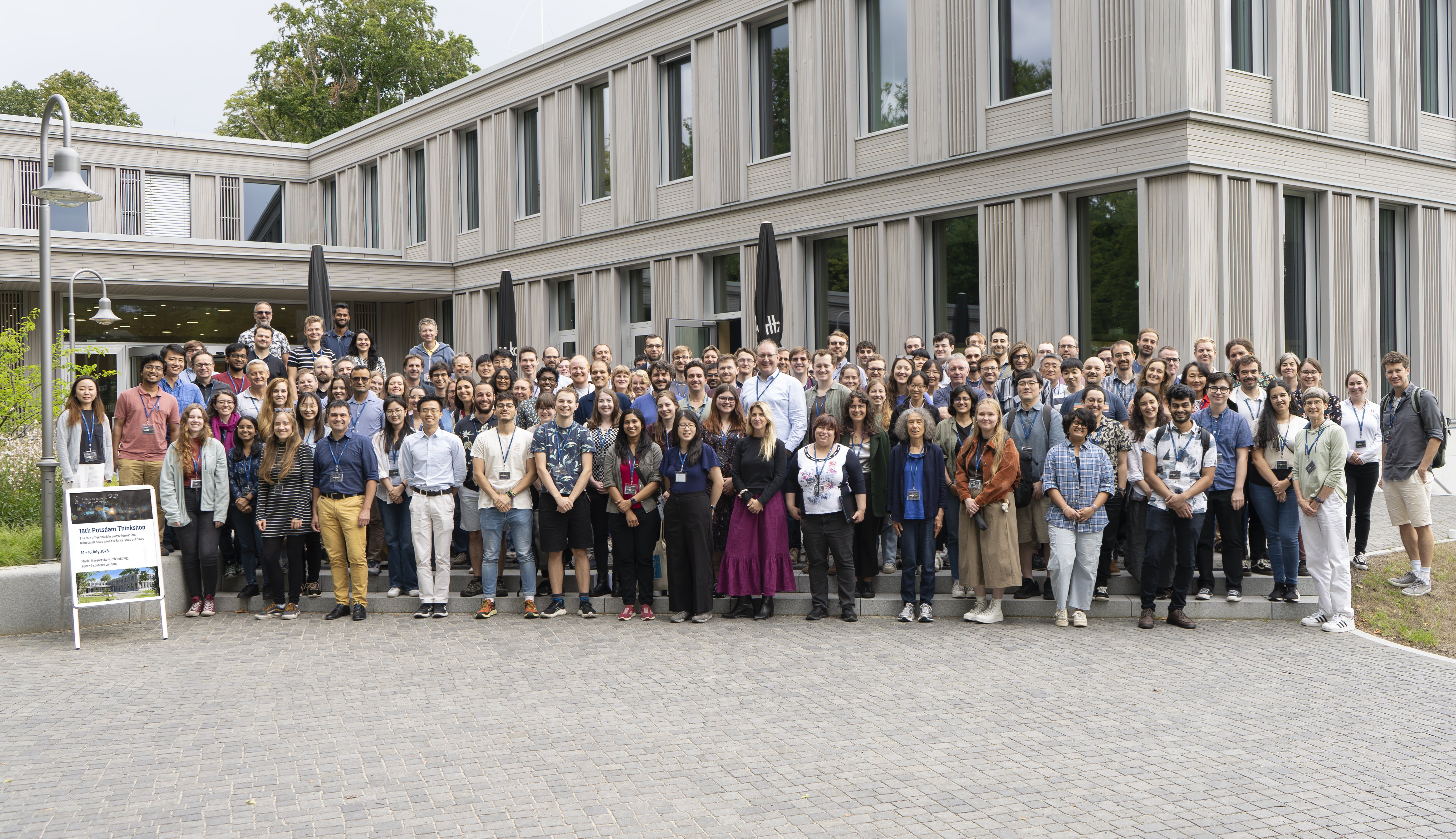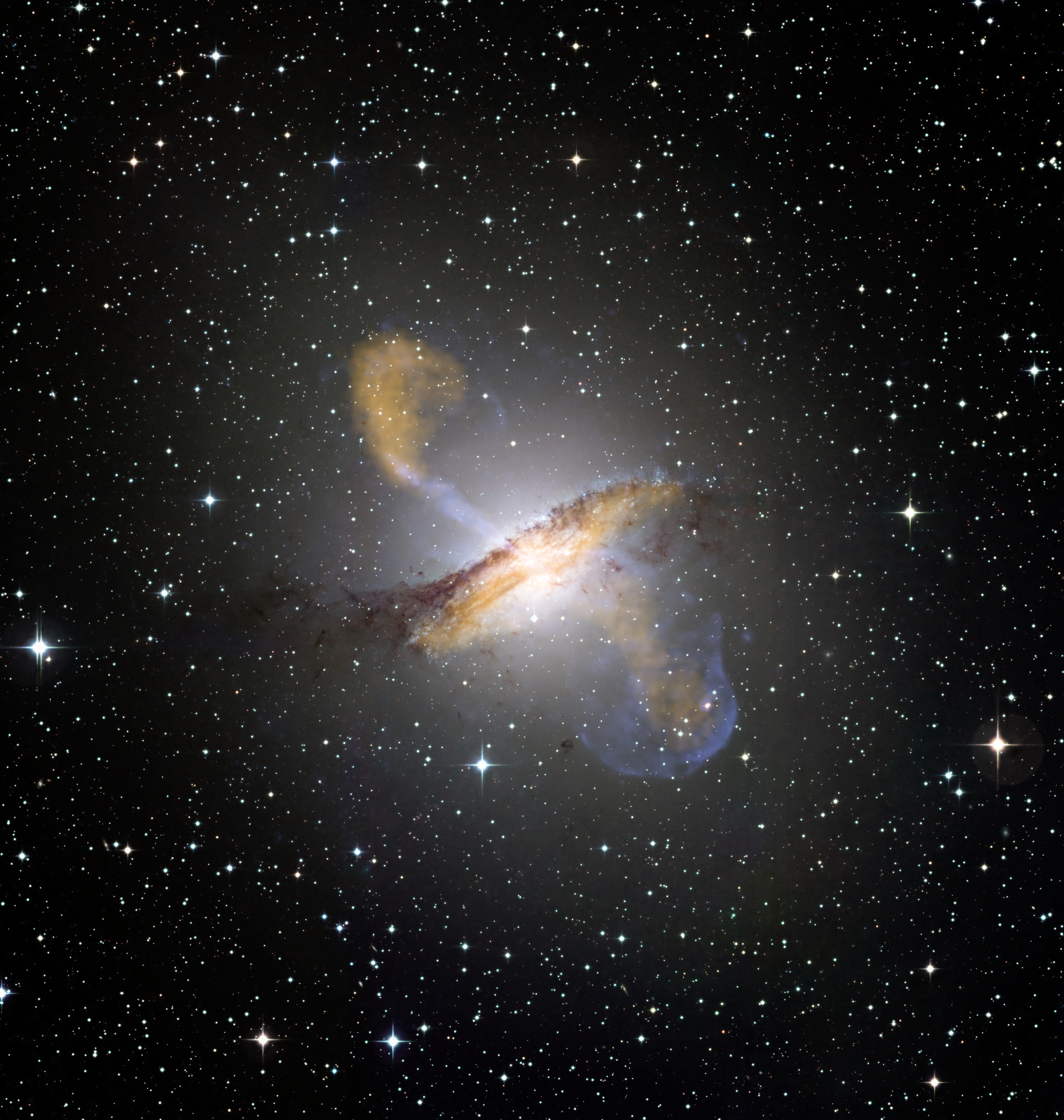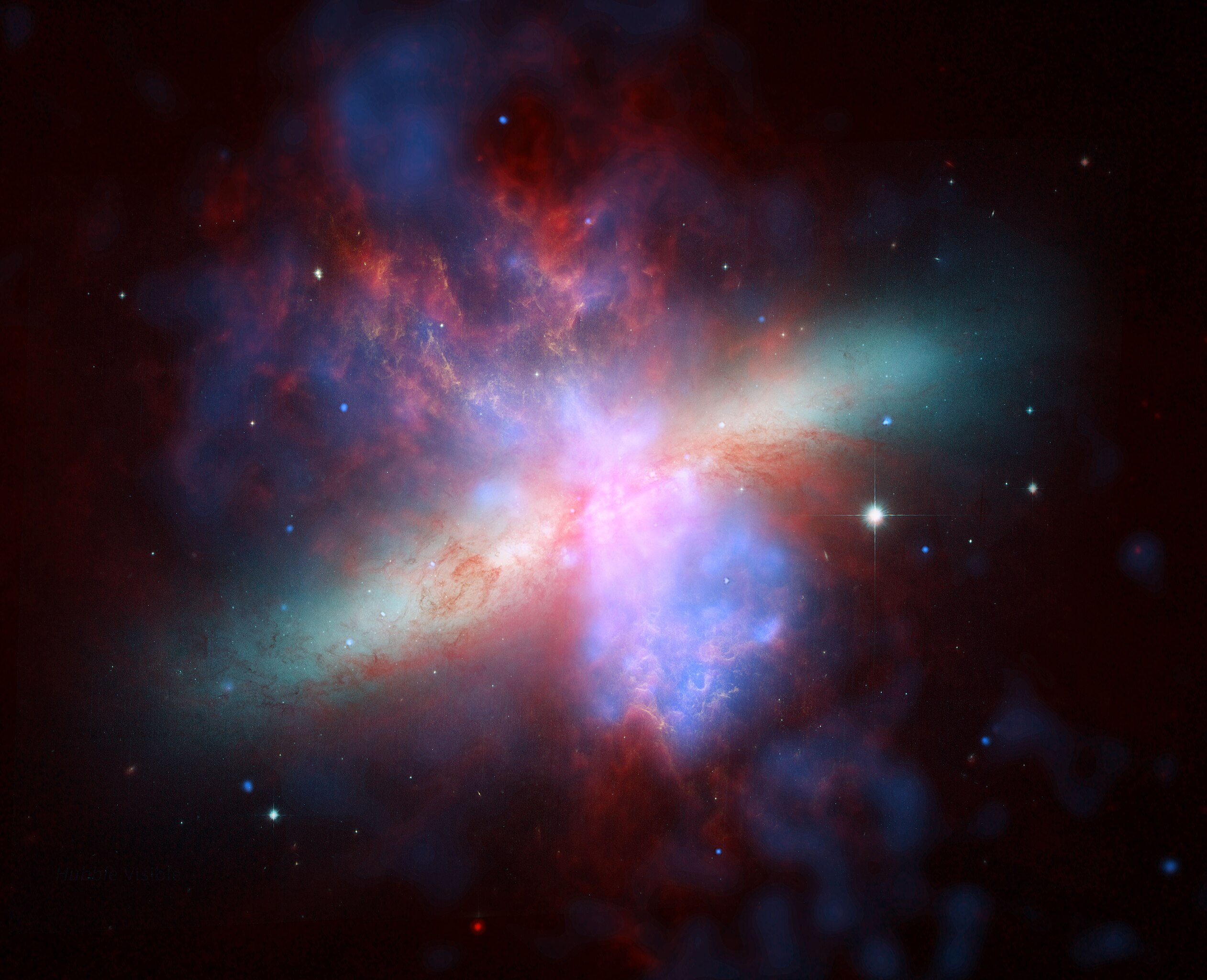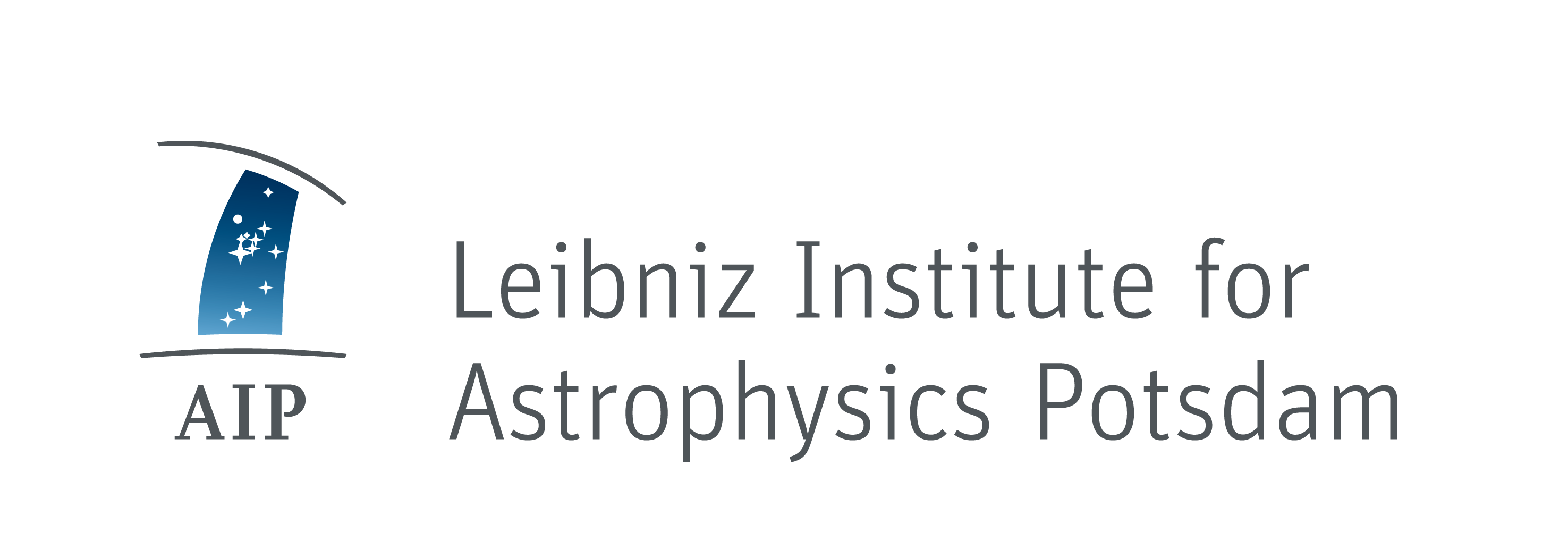- Indico style
- Indico style - inline minutes
- Indico style - numbered
- Indico style - numbered + minutes
- Indico Weeks View
18th Potsdam Thinkshop
→
Europe/Berlin
Conference Room, Maria-Margaretha-Kirch building (Leibniz Institute for Astrophysics Potsdam (AIP))
Conference Room, Maria-Margaretha-Kirch building
Leibniz Institute for Astrophysics Potsdam (AIP)
An der Sternwarte 16
14482 Potsdam, Germany
Description

When: July 14 - 18, 2025 (starts with a reception on July 13, 17:00)
Where: Potsdam, Germany
Contact: cpfrommer@aip.de
Abstract
We intend to host the 18th Potsdam Thinkshop in 2025, with a focus on understanding the role of feedback in galaxy formation. We plan to cover all subjects directly related to feedback including stellar and active galactic nuclei feedback, interstellar medium, circumgalactic medium, mechanical feedback, magnetic fields and cosmic rays, radiative feedback, etc. from both an observational and theoretical point of view.
Photos
Please browse through the photos from the Thinkshop.
Social media
Please join us on Bluesky at #thinkshop2025
Scientific Rationale

Centaurus A. Image Credit: ESO and Chandra composite image.
Galaxies come in various shapes and sizes ranging from spirals to ellipticals - which processes are mainly responsible for their formation and appearance? How do transformative processes affect the characteristics of galaxies? Observations indicate that the mass of a galaxy is a discriminating factor in its ability to effectively turn gas into stars. But why are galaxies like our own Milky Way apparently the most efficient in producing stars, while dwarf galaxies and galaxy clusters struggle? Is "feedback" the answer? and if so, what is the underlying physics? Or do we need to go beyond Occam's razor and add additional interactions to otherwise cold dark matter? What do we know for sure, which ideas play most likely an important role and what is pure speculation about our modern understanding of galaxy formation?
The number of observational studies of galaxies is rapidly increasing as a consequence of new techniques such as integral field spectroscopy, and major improvements at radio, optical, infrared, ultraviolet, X-ray, and gamma-ray frequencies. In particular, recent JWST and MUSE observations have sharpened our understanding of the ISM in nearby galaxies, the emergence of galactic winds and opened up new puzzles about the early growth history of galaxies at high redshifts. These observations over the entire electro-magnetic spectrum have allowed astronomers to spatially resolve internal properties of galaxies with unprecedented detail, and are thus providing key insights towards understanding the structural components of galaxies, their star-formation processes, kinematics, stellar populations, metal distribution, and nuclear activity, as well as how galaxies evolve with time. They provide important clues of how cold gas accretes from the circumgalactic medium (CGM), collects in the disk, is converted into stars and returned to the CGM in this cosmic cycle of baryons.

M82. Image Credit: Hubble and Chandra Composite image
These endeavours are complemented by the latest generation of galaxy simulations, which push forward higher resolution and model the multi-scale physics of the interstellar and circumgalactic media in ever-increasing detail. These simulations can derive insights from idealized problem setups of small-scale physics, including but not limited to the multi-phase structure of galaxies and plasma physics processes. Those models are accompanied by simulations that trace galaxy evolution following the hierarchical Lambda cold dark matter scenario with many physical processes included, opening the possibility of performing realistic mock observations and comparisons to observational data.
The aim of the 18th AIP Thinkshop is to bring together leading international experts and young researchers working in both Galactic and extragalactic astronomy. We aim to discuss the different physical feedback processes shaping galaxies, including stellar and AGN feedback, mechanical feedback, magnetic fields and cosmic rays, radiative feedback, etc. from both an observational and theoretical point of view. We will also discuss the interplay of the different components of a galaxy (stars, interstellar and circumgalactic media, non-thermal components including cosmic rays, magnetic fields, and turbulence, dust, and dark matter), and whether we can find smoking-gun observables identifying the dominating feedback agents during some specific epoch and halo mass range. The final objective is to reach a better understanding on the feedback processes that rule the evolution of galaxies.
Topics
- The role of feedback in self-regulating star formation and ISM properties in galaxies
- Physical properties of gaseous halos and imprints of feedback on them
- Circulation of metals and gas in and out of galaxies
- Observational evidence for feedback
- Theoretical challenges in modelling feedback
- Galaxies: stellar feedback
- Active galactic nuclei feedback
- Feedback via supernovae, cosmic rays and radiation
- Impact of cosmological environment on feedback processes
Previous Thinkshop on “The role of feedback in galaxy formation”
After the great success of our inaugural Thinkshop on “The role of feedback in galaxy formation” in 2018, we would now like to discuss the progress in this exciting and vibrant field since then. Please have a look at the website of the previous Thinkshop 15 to get an idea of what to expect from the planned event in 2025.
 |
Header image: The Galactic Center in Radio from MeerKAT
Image Credit: Ian Heywood (Oxford U.), SARAO; Color Processing: Juan Carlos Munoz-Mateos (ESO)
Registration
Thinkshop 2025 - Registration for Watching Talks Remotely via Zoom
Participants
Aditi Vijayan
Alankar Dutta
Alexander Beckett
Allison Matthews
Alvaro Segovia Otero
Anatole Storck
Andrea Afruni
Andrey Kravtsov
Annalisa Pillepich
Arghyadeep Basu
Ava Polzin
Benedikt Diemer
Benjamin Floyd
Brandon Sike
Camilla Thune Nyhagen
Capucine Barfety
Cassandra Lochhaas
Celine Peroux
Cheonsu Kang
Christoph Pfrommer
Christopher Garling
Clarke Esmerian
Cristina Ramos-Almeida
Crystal Martin
Daniel DeFelippis
Daniel Jiménez López
Daniel Karner
Daria Kozlova
Debora Sijacki
Debosmita Pathak
Duarte Muñoz Santos
Eileen Herwig
Ellen Zweibel
Enrica Bellocchi
Enrico Garaldi
Eric Zhang
Eva Schinnerer
Evan Scannapieco
Ewald Puchwein
Ezra Sukay
Feng Yuan
Fernando Hidalgo Pineda
Francesco Bollati
Francisco Rodriguez Montero
Giacomo Venturi
Giulia Pruto
Hanjue Zhu
Harley Katz
Hilay Shah
Hitesh Kishore Das
Houda Haidar
Hsiang Yi Karen Yang
Isabella Lamperti
Ismael Alejandro Pessa Gutierrez
Jade Gray
Jake Bennett
Jakob Walcher
Jia Wei Teh
Jonathan Stern
Joseph Whittingham
Karin Kjellgren
Karl Joakim Rosdahl
Kastytis Zubovas
Kathryn Kreckel
Kirsten Hall
Larissa Tevlin
Laura Hermosa Muñoz
Lise Ramambason
Lucia Armillotta
Lutz Wisotzki
Mandy Chen
Marcus Brüggen
Margaritis Chatzis
Maria Vittoria Zanchettin
Maria Werhahn
Marina Ruiz-García
Martin Wendt
Mateusz Ruszkowski
Matthew Pieri
Matthew Smith
Matthias Steinmetz
Matthias Weber
Matthieu Schaller
Max Gronke
Maxime Rey
Meredith Powell
Miha Cernetic
Ming-Yi Lin
Mohammadreza Ayromlou
Natascha Förster Schreiber
Nele Stachlys
Nicholas Choustikov
Nicolas Bouche
Nicole Thomas
Nicolás Guerra Varas
Noam Libeskind
Oleg Egorov
Patrick Hennebelle
Philipp Girichidis
Philipp Grete
Rainer Weinberger
Ralf-Jürgen Dettmar
Ramona Augustin
Ritali Ghosh
Roark Habegger
Roland Crocker
Rosie Talbot
Samuel Ward
Sandro Tacchella
Shubham Raghuvanshi
Sirio Belli
Stefanie Walch-Gassner
Tanya Urrutia
Taysun Kimm
Thorsten Naab
Tiago Costa
Timon Thomas
Tobias Buck
Tobias Looser
Vadim Semenov
Vance Wheeler
Victoria Fawcett
Volker Springel
Víctor Rufo Pastor
Xinyue Liang
Yohan Dubois
Yu-Ching Chen
Yucheng Guo
Zsofi Igo
Zuzanna Kocjan
- +19
SOC chairs
